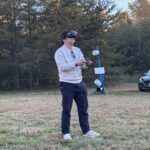ESSIC Researchers Jianping Mao and Anand Ramanathan were part of a recent study that utilized CO2 measurements taken by the passive miniaturized laser heterodyne radiometer (Mini-LHR) at the Mauna Loa Observatory in Hawaii. Working in tandem with an AERONET sun photometer that measures aerosol optical depth during daylight hours, the study concludes that the technology offers a low-cost, small, portable sensor to measure atmospheric gases such as ozone, water vapor, methane, ammonia, chlorine monoxide, and nitrous oxide. The results were published in Applied Physics B, September 2015, Volume 120, Issue 4, pp 609-615 http://link.springer.com/article/10.1007/s00340-015-6172-3/fulltext.html.





